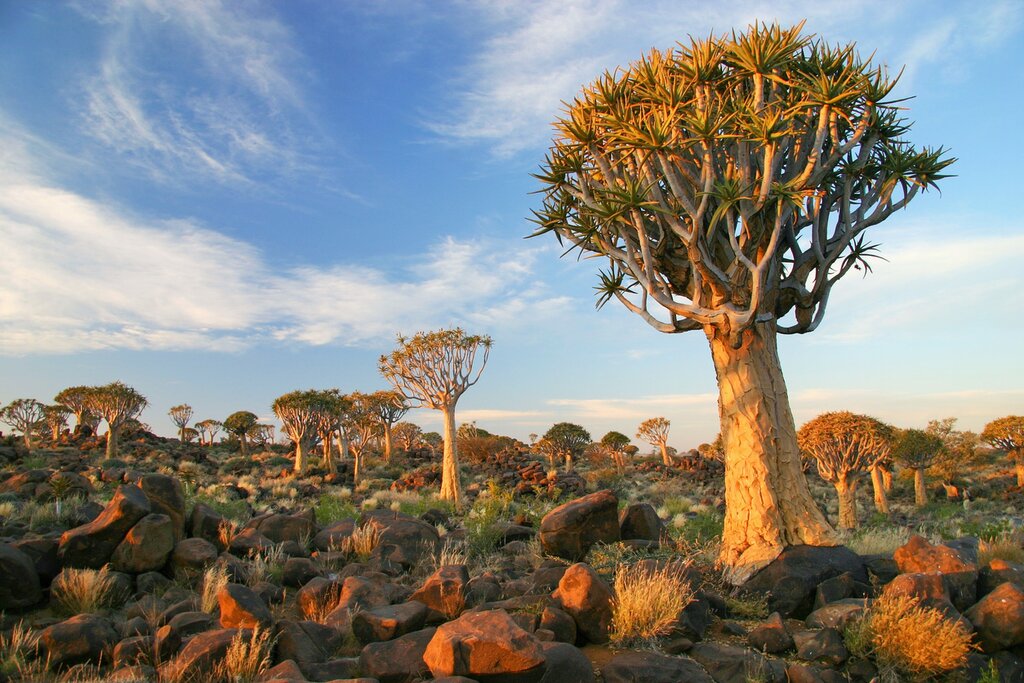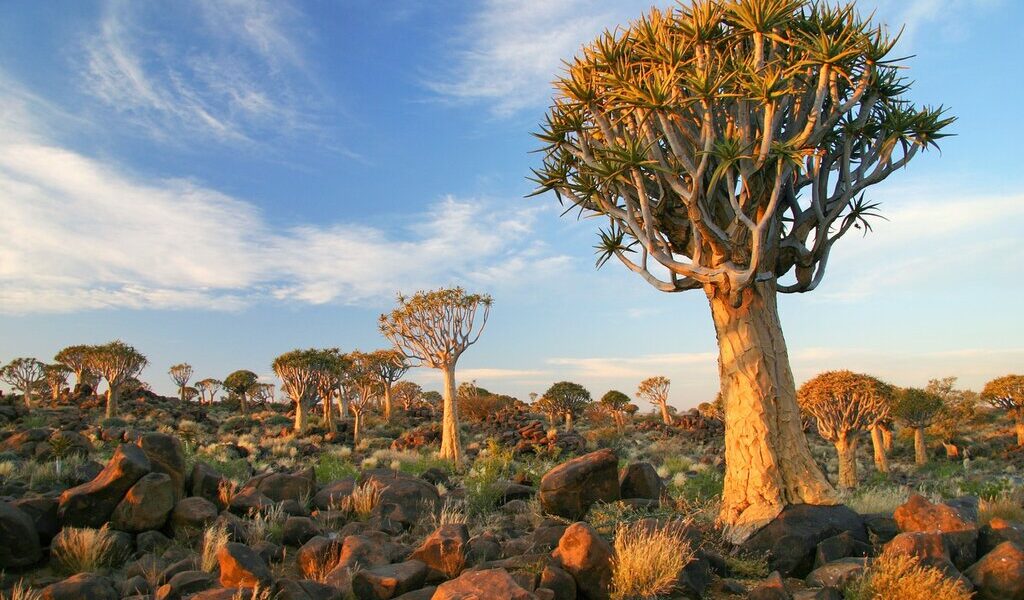
April is fall in Namibia and a great time to visit to enjoy warm temperatures, lush landscapes, and cultural festivals. Photographers of all skill and experience levels will find this an excellent month to travel through the varied country, offering lush and desert landscapes, attractive cities, and awe-inspiring expanses. Find out more about traveling to Namibia in April.
## Weather in Namibia in April
April in Namibia marks the arrival of autumn, a brief and beautiful transition between the hot, often humid days of summer and the cooler, drier months of winter. For many travelers, this period is considered an exceptionally appealing time to explore the diverse landscapes and attractions that Namibia has to offer. The weather in April is generally characterized by pleasant warmth, avoiding the intense heat experienced during the height of summer. Rainfall is minimal, contributing to clear skies and comfortable conditions for outdoor activities. Furthermore, the landscape retains the lush greenery that follows the summer rains, providing a visually stunning backdrop for your Namibian adventure, except, of course, in the typically arid desert regions.
Across Namibia, average temperatures in April typically fluctuate between a comfortable 73°F (23°C) and a balmy 86°F (30°C). The northeastern Caprivi Strip, known for its verdant landscapes and abundant wildlife, tends to experience temperatures at the higher end of this range. In contrast, the enigmatic and rugged Skeleton Coast, with its dramatic coastline, generally sees temperatures on the lower end of the scale. It’s important to note that nighttime temperatures can drop significantly in many parts of Namibia, especially in desert areas and at higher altitudes. Even in Windhoek, the capital city situated inland, you can anticipate overnight lows to dip to around 55°F (13°C), and possibly even colder, so packing accordingly is advisable.
## Crowds and Costs During April
April in Namibia is typically regarded as a shoulder season, offering a balance between favorable weather and fewer crowds. While the weather is generally suitable for travel and exploration, it’s not necessarily the absolute ideal time for game viewing, which is undoubtedly one of the primary attractions for visitors to Namibia. Due to the lingering vegetation after the rainy season, spotting wildlife can sometimes be a bit more challenging.
However, Namibia remains a relatively less-traveled safari destination compared to some other African countries. Therefore, even during peak seasons, the presence of large tourist crowds is usually not overwhelming. If your primary interest lies in activities other than wildlife viewing within the national parks, April presents an excellent opportunity to visit, allowing you to avoid the larger influx of travelers associated with peak season and potentially benefit from more favorable prices on accommodations and tours.
It’s worth noting that if the Easter holiday falls within April, there might be a slight increase in tourism. In addition to international travelers taking advantage of the holiday break, many local Namibian families also tend to travel during this period. Popular destinations among locals include Windhoek, Okahandja, and Rehoboth, as well as the charming coastal towns of Swakopmund, Walvis Bay, and Henties Bay. Therefore, if your travel plans coincide with the Easter holiday and you intend to visit these locations, it’s highly recommended to book your accommodations well in advance to ensure availability.
## Where to Go in Namibia in April
The Skeleton Coast, known for its consistently cooler temperatures throughout the year, including the autumn months, is an excellent choice for a visit during April. Situated along the northwestern coast of Namibia, the Skeleton Coast National Park stretches along a remote and captivating coastline, famous for its dramatic scenery and the haunting “skeletons” of shipwrecks that dot the landscape. This unique combination of natural beauty and historical remnants makes it a photographer’s paradise, offering endless opportunities for capturing stunning and evocative images. The southern regions of the park are generally more accessible and can be explored via guided 4WD tours. However, the northern regions are more remote and only accessible by air, providing a truly exclusive and unforgettable experience.
For avid bird watchers, the Caprivi Strip is an absolute must-visit destination in April. This elongated, narrow stretch of land in northeastern Namibia is typically one of the hottest regions in the country, but the temperatures in April are generally more comfortable than during the peak of summer. The Caprivi Strip is renowned for its incredible diversity of bird species, with over 450 different species reportedly found within its borders. Due to its proximity to the renowned Okavango Delta, the Caprivi Strip is also home to several bird species that are not commonly found in other parts of Namibia, making it a truly unique and rewarding destination for bird enthusiasts.
## What to Do in Namibia in April
Namibia in April is a dream come true for photographers, both amateur and professional. Besides the wealth of birdlife found in the Caprivi Strip and the stunning flocks of flamingos that grace Walvis Bay, the national parks are transformed into vibrant green landscapes following the summer rains. While spotting wildlife might be a bit more challenging due to the increased vegetation, the breathtaking scenery more than makes up for it. Additionally, the year-round beauty of the Skeleton Coast, as well as the starkly beautiful arid landscapes of Sossusvlei and Deadvlei, with their iconic dead trees and towering golden dunes, offer exceptional photographic subjects.
Whether you are a passionate photographer or simply intrigued by traditional cultures, consider heading to the Aawambo communities in northern Namibia in late March or early April to experience the Oshituthi Shomagongo, also known as the Marula Fruit Festival. This festival, recognized by UNESCO as a significant intangible cultural heritage tradition, revolves around the beverage crafted from the marula fruit. During the festival, men traditionally carve utensils and serving tools, while women skillfully create baskets and pots. Communities come together to celebrate with traditional songs, poetry recitations, and captivating storytelling. The festival is hosted by a different Aawambo community each year, so enlisting the services of a guided tour is highly recommended to ensure you have the best possible experience and gain a deeper understanding of this rich cultural tradition.
## Events in Namibia in April
**Easter**, **nationwide**. Easter, which can fall in either March or April, is a significant public holiday in Namibia, a predominantly Christian nation with strong Lutheran and Catholic traditions. Expect some closures of businesses and services, and be aware that domestic travel may be more prevalent both before and after the Easter weekend.
**Oshituthi Shomagongo**, **northern Namibia**. This UNESCO Intangible Cultural Heritage festival, spanning three days in late March and early April, brings together Aawambo (Ovambo) communities in a celebration of their cultural heritage. Participants gather to prepare omagongo, a traditional drink made from the prized marula fruit, and engage in various cultural activities.
**Windhoek Karneval**, **Windhoek**. Experience the vibrant atmosphere of the Windhoek Karneval, a Germanic-inspired carnival held annually in the capital city in late March or early April. The festivities include a colorful street parade and a lively costumed ball, offering a unique glimpse into Namibia’s cultural diversity.
B-1697

